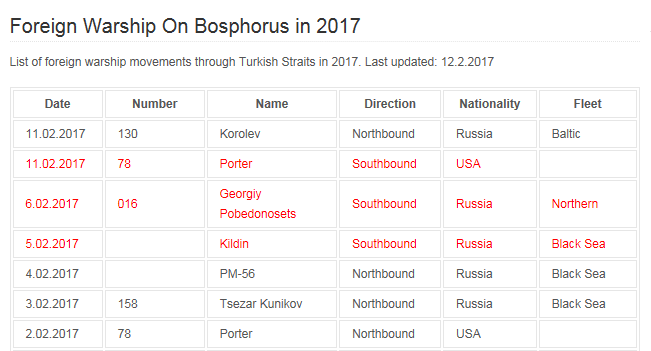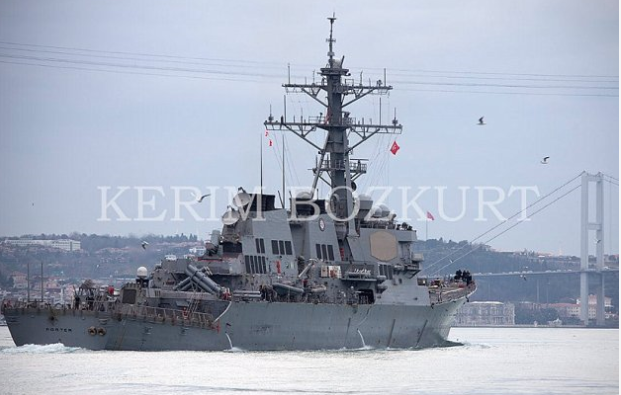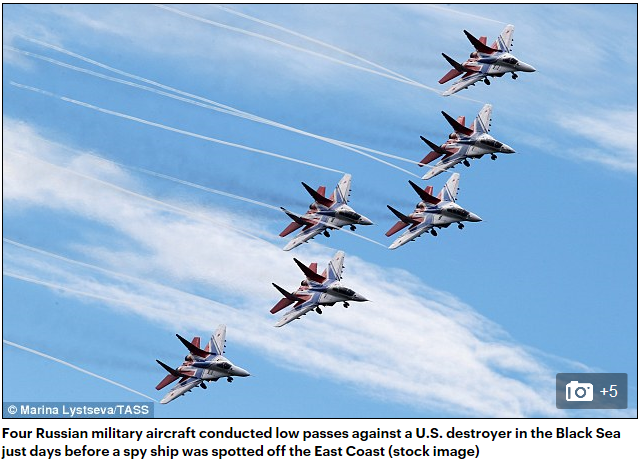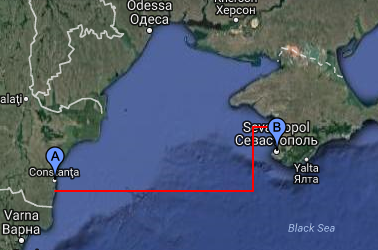By John Helmer, Moscow
The US nuclear-armed missile destroyer, USS Porter, was steaming full-speed across the Black Sea in the direction of the Russian coastline, its Tomahawk firing radars activated, when a Russian airborne signals reconnaissance aircraft and three SU-24 fighter-bombers arrived in three waves. The US European Command headquarters in Stuttgart announced that the incidents had occurred on Tuesday, February 14, calling the Russian flights “unsafe and unprofessional”, putting the vessel and the militaries of the US and Russia at risk of “accident or miscalculation.” The Pentagon repeated the exact words after daylight broke on the same day in Washington. But that was four days after the incidents had actually taken place on Friday, February 10. The Russian Defense Ministry replied in the Moscow evening of February 14 that there “were no incidents”.
The release this week of news, or no news, or fake news has occurred on the eve of Thursday’s meeting between the US and Russian chiefs of the General Staffs, General Joseph Dunford and General Valery Gerasimov. Dunford, a Marine Corps officer, was appointed to the Pentagon post, the most senior ranking uniform officer under Commander-in-Chief Donald Trump, by former President Barack Obama on October 1, 2015. Dunford’s 2-year term runs out in eight months’ time. A statement from Dunford’s office, issued yesterday, claims the meeting, to be held in Baku, Azerbaijan, “will discuss a variety of issues, including the current state of U.S.-Russian military relations and the importance of consistent and clear military-to-military communication to prevent miscalculation and potential crises.”
Moscow sources in a position to know believe the US military was either exaggerating, or faking, last week’s incidents around the USS Porter – Destroyer Designated Guided, DDG-78 is its fleet number — in order to put pressure on President Trump’s readiness to relax the US policy of all-fronts confrontation with the Kremlin.
The USS Porter interceptions, if they happened, are the first to be delayed in their public disclosure for several days. They are also the first not to be accompanied by videoclips shot from the decks of the US warships, and released through Pentagon-friendly websites. For analysis of earlier interceptions in the Black Sea and the Baltic, along with the video evidence, read this and this. For the videoclip from the deck of the USS Ross (DDG-71), a sister ship of the USS Porter in the Aegis-class of nuclear-warhead firing warships, also in the Black Sea, but on May 30, 2015, click to watch.
According to the European Command (EUCOM) version and the Pentagon repeat of what happened in the vicinity of the USS Porter at the time of the incident, the Porter was “conducting routine maritime operations in international waters in the Black Sea following the conclusion of Exercise Sea Shield.”
No official press release from either EUCOM or the US Defense Department exists. Instead, the incident claims were leaked to US news outlets. Lieutenant-Colonel Michelle Baldanza (pictured below, left) , the Pentagon spokesman, claimed to a US television network: “the first encounter involved a Russian Ilyushin 38 [below, right], a maritime patrol and anti-submarine aircraft. The plane ‘flew in an unsafe and unprofessional manner due to the unusually low altitude’ above the Porter. The second incident involved two SU-24 fighters and the third a different Su-24. A U.S. official said one of the fighters flew 300 feet above the Porter.”
Baldanza also told ABC TV that Russia had deployed a new type of cruise missile at one or two land bases in violation of the Intermediate-Range Nuclear Forces Treaty (INF, 1987); and also of running a spy ship, the Viktor Leonov, 70 nautical miles off the US east coast, near the US Navy submarine base at New London, Connecticut.
Captain Danny Hernandez, spokesman for EUCOM in Stuttgart, claimed in this US Naval Institute report, released in the German evening of February 14, that there had been three separate incidents – a fly-over by a pair of Su-24s in tandem; a separate SU-24 flight; and one flight by an Il-38. The aircraft had made “low-altitude, high-speed passes”, and “at least one Fencer [NATO code-name for the SU-24] came within 200 yards of the ship, flying at 300 feet at more than 500 knots”. However, no pictures of the incidents have been released by the US, and according to EUCOM “it’s unclear if the Fencers were armed.” That means that from the deck of the USS Porter, the distance wasn’t close enough for the US crew to determine if the SU-24 aircrafts’ 8 underwing hard-points were carrying rockets, missiles, bombs, torpedoes, etc. The Il-38 is unarmed.
The position of the Porter has not been reported either. According to EUCOM and the Pentagon, the destroyer was “operating in international waters in the Black Sea” and “had just completed the ten-day Romanian-led multinational Sea Shield 2017 exercise”.
The US Navy has released this picture of the Porter casting off from its berth at Constanta on the afternoon of February 8:

Source: http://www.c6f.navy.mil/news/uss-porter-departs-constanta-romania-1
The Russian Defense Ministry isn’t saying where the interceptions were made. However, US records reveal a gap between the Porter leaving Constanta and passing through the Bosphorus, and out of the Black Sea, on February 11. The distance between the two is 197 nautical miles.
The Porter’s top-rated speed is more than 30 knots, but its cruising speed is around 20 knots. At that rate, it would have taken about 8 hours to sail from Constanta to the Bosphorus. In fact, the vessel took three days. In other words, the Porter was sailing either north towards the Russian naval base at Sevastopol, Crimea; or east towards the Russian mainland, between Novorossiysk and Sochi. There was no stop southwards in Bulgaria (last visited by the Porter in July 2015 and June 2016).
The distance between Constanta and Sevastopol is 273 nautical miles; about 14 hours slow steaming for the Porter. The distance between Constanta and Novorossiiysk is 438 nm, or about 22 hours. If Porter had been heading either north or east, it would have reached Russian territorial waters by dawn of February 9. The interceptions, if they happened, did not occur for more than another 24 hours. That means the vessel was under constant Russian surveillance before the Ilyushin and the Sukhois arrived.
CLICK ON MAPS TO ENLARGE
After the US vessel’s reported engagement with the incoming Russian Air Force, the Turkish Navy reports that the Porter headed south for 24 hours and out of the Black Sea; that was on the afternoon of the next day.

Source: https://turkishnavy.net/foreign-warship-on-bosphorus/foreign-warship-on-bosphorus-in-2017/
The Turkish source published this photograph of the Porter heading southwards in daylight through the Bosphorus:

Source: https://turkishnavy.net/foreign-warship-on-bosphorus/foreign-warship-on-bosphorus-in-2017/
On the morning of February 15, by the time the USS Porter was unscathed and at a berth in Souda Bay, Crete, the London Daily Mail headlined: “Russia tests the waters: Military jets buzz a US destroyer in the Black Sea, Moscow tests a new cruise missile in violation of arms treaty and deploys a spy ship off the coast of Delaware as Trump’s NSA is in disarray.”
The newspaper’s version included this illustration of Russian Air Force acrobatic stunt aircraft, MiG-29s, not SU-24s, and six incoming, not four. Read the caption to follow.

Source: http://www.dailymail.co.uk/news/article-4224832/Military-jets-buzzed-destroyer-Black-Sea.html
Since the incident on February 10, the Russian Defence Ministry has issued 30 press releases, an average of five every day covering everything from sniper contests to shore shelling practice by the Russian cruiser Varyag in the Pacific. There has been no mention of an incident in the Black Sea at all. The Russian Navy has also kept shtum.
There was no word from Moscow until the Pentagon’s Baldanza escalated from EUCOM’s Hernandez, although the US Defense Department has issued no official claim about the incident in the week since February 10. However, late in the Moscow evening of February 14, Moscow time, the two American spokesman got tit for tat. The Russian Defence Ministry spokesman, Major-General Igor Konashenkov, sent a statement to the Russian state news agencies, Sputnik and RT. “There were no incidents related to a flyby of Russian military aircraft near the USS Porter destroyer in the Black Sea on February 10,” Konashenkov said. This was not exactly a denial that there had been Russian aircraft on patrol in the sector of the Black Sea where the Porter was under way. It was a denial that there had been a close-in encounter, low-level flyby, or buzzing. “All of our flights were conducted and are being conducted over the neutral waters of the Black Sea in accordance with international rules and safety requirements.”
Konashenkov (right) added a reminder of whose warship was near whose territory. “If the US destroyer, as the Pentagon official claims, conducted a ‘regular’ patrol mission in the vicinity of Russia, tens of thousands miles away from their own shores, it is strange to be surprised about the no less regular flights of our aircraft over the Black Sea.”
“If the US destroyer, as the Pentagon official claims, conducted a ‘regular’ patrol mission in the vicinity of Russia, tens of thousands miles away from their own shores, it is strange to be surprised about the no less regular flights of our aircraft over the Black Sea.”
That this was as obvious to Konashenkov as it was to the Pentagon goes without saying. So why was so much said, so late after the event, and perhaps after no event at all? Moscow sources in a position to know believe the Porter incident was staged to send a message to only one incredulous member of the US chain of command – Trump. “If that happened in the Russian Navy,” comments one of the sources, “Putin would consider it mutiny.”
















Leave a Reply